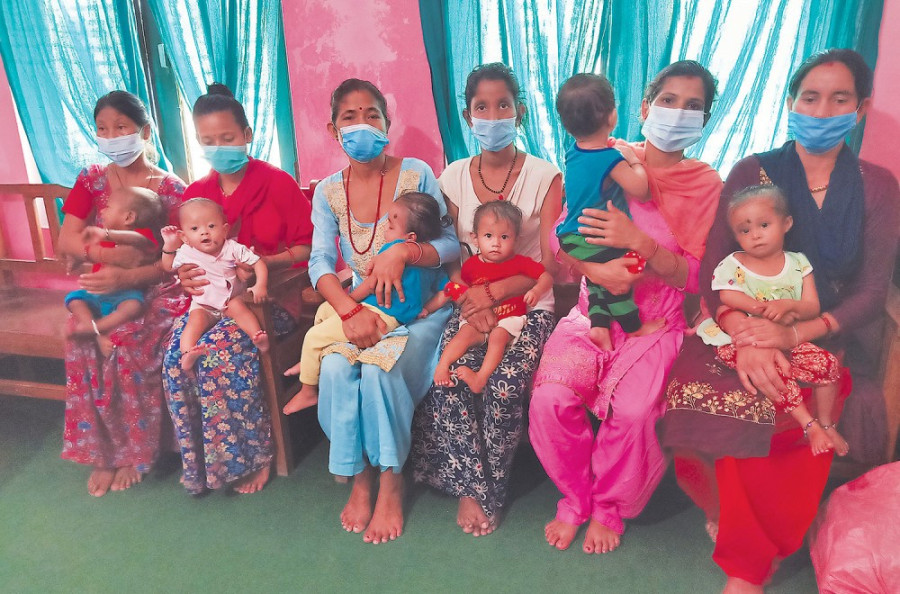Editorial
An integrated social registry for Nepal
Social protection programmes cover about a third of the population but are yet to reach all the poor and vulnerable.
Faris Hadad-Zervos & Lynne Sherburne-benz
Imagine the following scenario. A mother delivers a child at a health facility. When the birth is recorded in the health information system, it notifies the ward office. The mother receives a call from the ward office to register her child’s birth. At the time of birth registration, she learns if the child is eligible to receive a child nutrition grant. She also receives information about vaccinations and early childhood education. The birth registration system is linked to a household registry. Each new birth also updates the household database providing the palika with an overview of all households and individuals at any time.
Such seamless access to services and information about benefits and services is unfortunately not quite what mothers face in Nepal. The lack of linkages is apparent if we just look at rates of facility delivery (77.5 percent) compared to birth registration before 12 months at (59.5 percent). That means over 17 percent of births that occur at health facilities are not registered in the first 12 months. One reason, among many, for low birth registration is a lack of integration both at the front-end (point of service delivery) and the back-end (information system).
Nepal is now working to establish an Integrated Social Registry, which can serve as a platform to link across social protection programmes and information systems and help address this issue, among several others.
Why it is necessary
In Nepal, there are multiple social protection programmes, including the Social Security Allowances (SSA), Prime Minister Employment Programme (PMEP), Safe Motherhood Programme, scholarships, and health subsidies. They cover about a third of the population but are yet to reach all the poor and vulnerable. Currently, less than 50 percent of the poorest households receive any social assistance. Proper identification of the eligible beneficiaries to ensure that all the eligible receive services is a challenge for Nepal which lacks robust information systems.
Currently, each programme in Nepal has its own beneficiary identification process and collects its own data that is managed in an information system that is not linked to the others. The government has been identifying poor households, but this database of poor households is not linked to programmes that need this data. Partly due to such fragmented information systems, not everyone who needs assistance is getting it. For example, not all the children eligible for child grants receive the cash. It is also difficult to say which household is receiving what benefit across programmes.
In this context, here are four ways an Integrated Social Registry can help, especially in the context of a green, resilient, and inclusive development approach that the government is leading on, to promote greater inclusion and resilience for Nepalis.
Integrated service delivery
As a comprehensive database of households, the Integrated Social Registry can provide an integrated platform that multiple social protection programmes can use. The Integrated Social Registry will pull together existing individual demographic data in the National ID civil registration database and household socio-economic data in one database. All programmes can use the same database to identify and enrol beneficiaries based on their eligibility criteria. In addition, the Integrated Social Registry can also promote better planning, delivery, and monitoring in the federal context. For each of the 753 local levels, the Integrated Social Registry would provide one robust household database that can be used by programmes at all three levels of government. The Integrated Social Registry is initially envisioned to be linked to three programmes: SSA, PMEP, and the National Health Insurance. Gradually, it will be made interoperable with other programmes in health including the safe motherhood, education, and beyond. Linkages across programmes, particularly in the early years, would help enable a seamless service delivery imagined at the beginning of this piece.
Greater efficiency and inclusion
The Integrated Social Registry can provide efficiency gains in the way the government collects and uses data by minimising the duplication of efforts across programmes. Linking the Integrated Social Registry to multiple programmes would mean that each programme would no longer need to collect the same household data. The Integrated Social Registry will also improve the government’s ability to better coordinate who is receiving what benefit and coordinate across programmes to expand coverage.
An Integrated Social Registry with a database of all households enables the palikas to identify everyone eligible for different programmes, thereby ensuring inclusion. For example, systematically reaching out to all mothers who deliver at health facilities and receive a safe motherhood allowance to register their child’s birth will help increase birth registration. Birth registration provides the child with an ID to access other programmes.
Improved crisis response
Nepali households are exposed to a variety of shocks, including natural disasters, climate-related hazards, economic crises, and pandemics. One in three households faces at least one shock in a year. By having data on all households in one place, governments can prepare better for disaster relief. By pre-identifying those who are vulnerable to shocks and those receiving any benefits, Integrated Social Registry will also improve the government’s ability to deliver relief and recovery faster during times of shocks while ensuring that the most vulnerable, who are often excluded, receive relief. The government is also developing guidelines for shock-responsive social protection which will enable the government to mobilise existing social protection programmes such as the SSA and PMEP to deliver relief and recovery faster and more efficiently. Integrated Social Registry will be essential to operationalising this guideline.
Learning from the Region
We have realised the importance of such a registry in our discussions in mitigating the impact of the current crisis on the poorest in Sri Lanka. It is clear from the experience there that the government’s response could have been accelerated if there was a registry that could help identify those who need assistance the most.
In the Covid-19 context, countries with robust registries were found to be faster and more efficient in delivering responses. Over 200 countries implemented cash transfers in response to the pandemic. A review of 98 Covid-19 relief programmes showed that an average of 26 days passed between programme announcement and payment but countries that had an existing social registry responded faster than others (within 11 days). The challenge of quickly determining who would be eligible for these transfers delayed the response in many countries, including Nepal.
For Nepal, now is an opportune moment to build on the foundations of the national ID and civil registration systems, and it is encouraging to see that the government has already approved the policy framework to establish the Integrated Social Registry and outlined a plan for its phased roll-out as a start. The development and testing of the Integrated Social Registry are planned under an ongoing World Bank-financed project, and we stand ready to support the roll out and use of the Integrated Social Registry for the benefit of all Nepalis. The success of this initiative will further depend on effective inter-ministerial cooperation and coordination.




 16.2°C Kathmandu
16.2°C Kathmandu
















